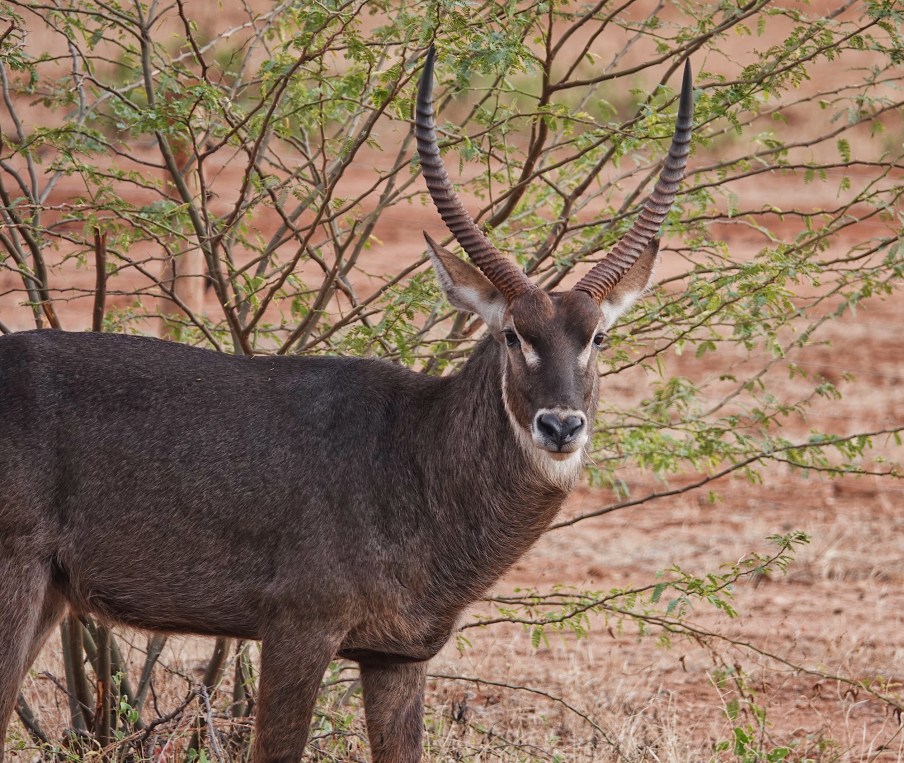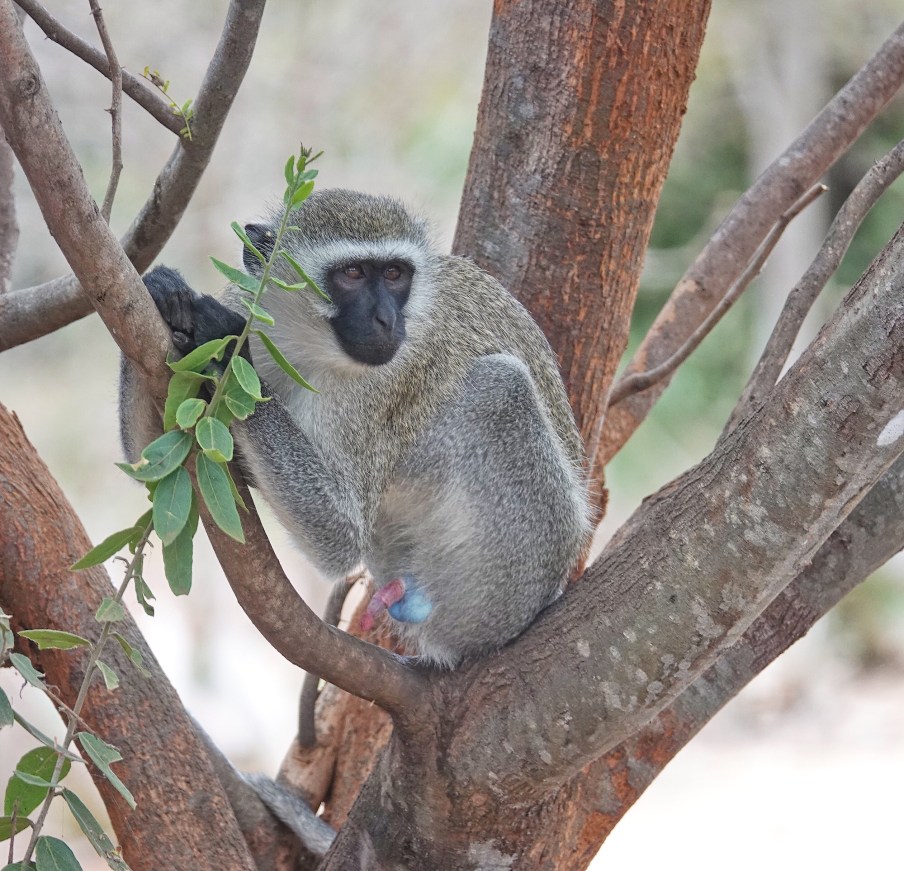Monthly Archives: October 2018
Ostrich Encounter

I am working on telling the story of my Kenyan Safari and have decided it is best told by “encounters”. Traveling in Kenya is hours of butt-busting, dusty, barely roads or road clogged with tractor-trailer trucks, mostly uncomfortable travel…interrupted by some of the most amazing wildlife encounters imaginable. This is the first small sample. To view it, tap or click the link and it should open as a pdf in your browser. It might take a few moments to load 🙂
Waterbuck
The Common Waterbuck is another of the very common antelope species in Kenya…especially in Tsavo East and West National Parks. Bucks are strongly built with impressive horns and females and young are on the cute side…so what is not to like? At Voi Safari Lodge they were often on inside of the fence with us, and in Tsavo East we saw many family groups and lone bucks. Sony RX10iv at mostly 600mm equivalent. Program mode. Processed in Polarr. (Touch or click any image to view at full size.)
Cokes Hartebeest



In my opinion, one of the oddest looking of Africa’s antelope species, the Cokes Hartebeest. The close ups were taken at Tsavo West National Park in Kenya, and the full body shot at Tsavo East. It is a heavy-set animal, with high shoulders which make it look taller in the front than in the back. But it is that long face, with the horns set so high and close together, and the bulb of a nose that stand out for me. It is also among the most common and wide-spread of the African antelope species. We saw them in every park and reserve we visited in Kenya. Sony RX10iv at 600mm equivalent. Program mode. Processed in Polarr.
Vervet Monkey
The most common monkey of all of sub-Sahara Africa is the Black-faced Vervet. It seems to have an affinity for humans (or perhaps only for human food) and is very apt to be seen around camps and lodges. In South Africa when I visited they were a real problem at lodges…so bold that at least one person was assigned to monkey duty at each meal, otherwise they would have been up on the tables helping themselves whenever your attention wavered. Even with a guard they got away the occasion slice of fruit or toast. In Kenya they were much more shy…or perhaps not as hungry…or the camp staff have done a better job of training them to be unobtrusive. Only at one camp we visited for lunch were there any number of them…yet we saw large troops in the bush. These shots are from a lodge well within Tsavo East National Park. Sony RX10iv at various focal lengths. Program mode. Processed in Polarr.
More of Amboseli’s Elephants on the move…
On our first afternoon drive at Amboseli National Park in Kenya, it was obvious that our driver was on a mission. He did not tell us what the mission was, but you tell that he was more or less killing time until something happened, and that he needed to be in right place at the right time for us to see it. As the sun started to set, the CB radio came alive with excited chatter and the final race was on. It is evidently a matter of some pride among the drivers to get their clients as close to the spot where the elephants choose to cross the road on that particular afternoon on their way to the slightly higher ground in the north section of the park to spend the night. There are several trails. As a guide, you can’t afford to guess wrong and have your clients miss the whole thing…and you can’t come late or they will be at the very back of the press of safari vans with not much of a view, and you can’t come early since your vehicle in the path might turn the herd to another trail. Timing is everything. You need among the first to arrive after the herd is committed to a trail. We were one van length from the trail they used that day. A bit crazy perhaps. I had to wonder would happen if one of those huge creatures decided to come through us instead of through the gap…but they all thundered through 20 feet from us. The shot above is of one of the “pioneer” elephants who was already across the road when we arrived, but within the next 10 minutes the heard joined him and they moved off to the north. The link below is to a video slideshow of the experience.
Wild Turkey

There are more Wild Turkeys in Southern Maine this fall than I have seen in many years. I have seen at least 4 different flocks of 20 or more along the back roads as I ride my eBike. Maybe there are always that many, and they just stay more hidden, but it seems like a lot. These were in the Senior Housing Condos behind Rt. 1 near the Wells line. Sony RX10iv at 600mm. Program mode. Processed in Polarr.
Red Elephants of Tsavo East
Tsavo East National Park in Kenya is famous for its “red elephants” and big tuskers. The elephants are not red of course, but the soil is full of red clay, and when the elephants are freshly “dusted”, and in the right light, they certainly look red. Elephants dust or mud themselves to protect their skin from the sun and insects. All elephants do it. It is just that the soil of Tsavo East turns them red when they do. The big tusks of Tsavo East are more of a mystery. Elephants with big tusks are increasingly rare in other areas of Kenya and Tanzania, but many remain at Tsavo East. No one knows exactly why. Sony RX10iv at 90mm, 350mm and 600mm. Program mode. Processed in Polarr. Note the corrugated tongue on the close-up. 🙂
Hippopotamuses in the water



I will admit to being somewhat startled when a pod of Hippopotamuses surfaced beside our small boat on Lake Naivasha. The boatman obviously expected it, and had brought us into this particular little cove for just that purpose…but still…he might have warned us. Hippopotamuses are big. Swamp-a-boat-easily big. And they just appear there, right beside you. So fast I could barely get the camera around to capture a few shots before they submerged again. The boatman stopped the boat, and we watched them for a few moments, enjoying themselves. Hippos spend the day submerged, coming up to breathe, or in mud flats where they can cover their sensitive skin with a layer of mud as sun-screen. They come out to browse the short grasses along the lake-shore at night. We stayed at Elsamere on Lake Naivasha, and one of its selling points (along with most of the other lodges on the shore) is that Hippos come out on the lawn at night. If you go to Africa, someone is sure to tell you that Hippopotamuses kill more people per year than any of the big five…than all of the big five added together…and it is true. It is easy to underestimate these huge, placid animals and get too close, or between them and their retreat to the water. They don’t tolerate that. So, I guess if you have to get close, in a boat is the way to do it. Sony RX10iv at 600mm equivalent. Program mode. Processed in Polarr.
Cape Buffalo among the Flamingos

Lake Nakuru National Reserve is one of the “fenced” reserves of the Rift Valley. The animals are not free to come and go…which is not the norm in Kenya. In fact the unfenced reserves and parks are, in my opinion, one of the main differences between the experience of Kenya and, say, South Africa, where the larger Kruger complex…though huge…is totally fenced. Nakuru is fenced to protect surviving small numbers of both endangered Black and White Rhinoceros…from wandering and from poachers…and a thriving herd of the comparatively rare Rothschild’s Giraffes, which were introduced to the park for their own protection. When lake levels are right, the lake also attracts large numbers of Lesser Flamingos, which, as here, feed in the shallows. The Cape Buffalo are on a little spit of more solid land that runs out into the lake. Our guide lamented the fact that the lake is being polluted with runoff from Nakuru Town, on its northern edge, which he feels is reducing the numbers of Flamingos, and pushing them to the far south edge of the lake. Sony RX10iv at 600mm equivalent. Program mode. Processed in Polarr.
Oryx



Oryx
Actually the “Fringe-eared Oryx”. I was surprised to find that there are two Oryxs possible in East Africa and Kenya, and that the “Fringe-eared” is more likely in Tsavo East National Park were we found these. I had to look closely at the photos, but they do indeed have the distinctive fringe of dark hair on the ears. We evidently did not get far enough north to see the other Oryx: the Beisa Oryx, very similar but without the ear-fringe. Sony RX10iv at 600mm equivalent. Program mode. Processed in Polarr.



















